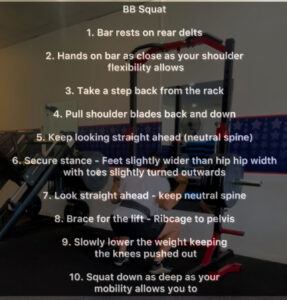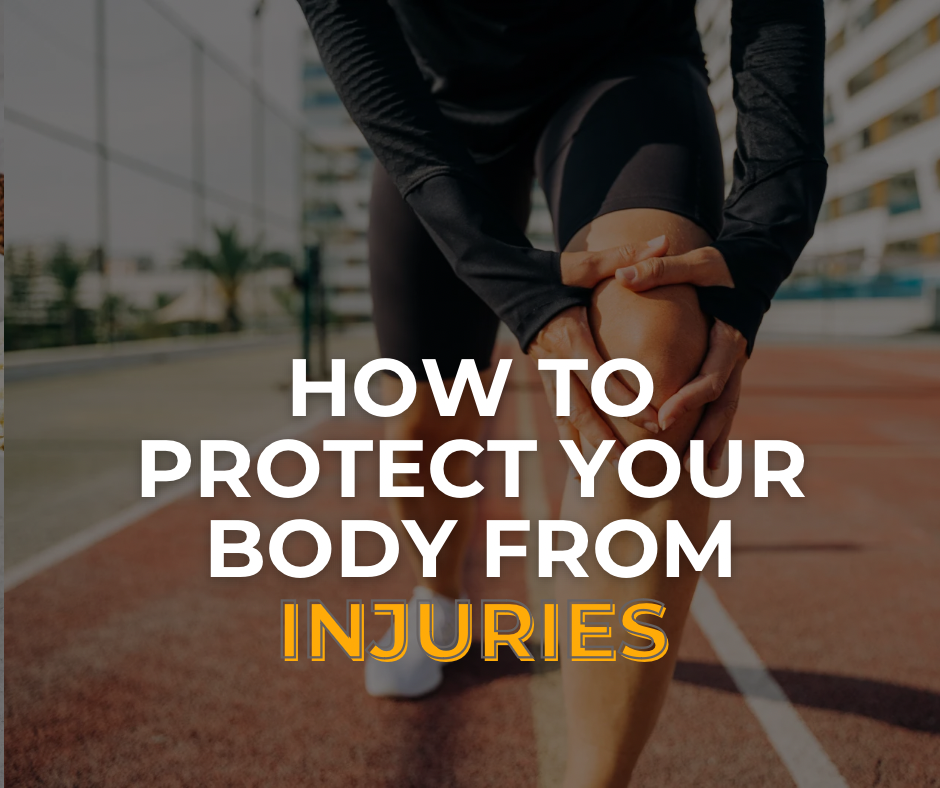How To Protect Your Body From Injuries.
Staying active is essential for maintaining health, fitness, and a great appearance. Whether introduced to sports at a young age or discovering them later in life, it’s never too late to start. Once you begin, you might find yourself hooked for life.
When starting a new physical activity, it’s crucial to prioritise safety and avoid overexertion. As you gain confidence and strength in your chosen sport, it’s important to remain cautious, ensuring your technique and approach to training is correct.
Preventing injuries is highly achievable. For recreational athletes, the risk of chronic injuries can be significantly reduced by managing one’s ego during training. From my experience in the fitness industry, acute injuries are rare and typically occur in environments such as competitive settings, especially in contact or impact sports and when you are training without proper focus on the task ahead.
Tips to Help Prevent Injuries
Warm-Up is Key:
A proper warm-up gets your blood flowing and prepares you both physically and mentally for the exercise ahead. Make sure your warm-up is specific to the movements you’ll be doing.
Example: On leg day, focus on warming up your quads, glutes, hamstrings, and core with dynamic stretching and light movements like bodyweight squats and leg swings.
Focus on Technique:
Prioritise good form over lifting heavy weights. Gradually increase your efforts and pay close attention to your movements during exercises. Understand the purpose of each exercise and execute it correctly.
Example: When doing squats, ensure your knees don’t go past your toes and your back remains straight to avoid injury.

Gradual Progression:
Build your training routine gradually. Start small and slowly increase the intensity and frequency of your workouts. Jumping from inactivity to intense training can lead to injuries. Remember, your joints and tendons need more time to recover than your muscles, so include low-impact activities regularly. Stick to the rule of 1-2% increments.
Example: If you’re new to running, start with a mix of walking and jogging, then slowly increase your running time each week.
Aid Recovery:
Help your body recover by flushing out toxins, which can reduce delayed onset muscle soreness (DOMS). This is also a good time for static stretching.
Example: After a workout, spend 10-15 minutes doing light activities like walking or cycling, followed by stretching to help reduce muscle soreness.
Nutrition and Supplementation:
Maintain a balanced diet and consider supplements to replace essential nutrients and minerals. This helps your body maximise the benefits of your workouts.
Example: Eating a protein-rich snack like a smoothie with protein powder or a handful of nuts and fruit after exercise can aid muscle recovery.
In Summary: Be smart, be mindful, and build up your routine over time. Think of building your body like constructing a great wall—one brick at a time, day after day, for lasting results.
How Do Sports Injuries Happen?
Sports injuries occur when a body part is pushed beyond its limits or subjected to direct impact. There are two types of injuries: acute and chronic.
- Acute injuries happen suddenly, such as spraining an ankle during a fall.
- Chronic injuries develop over time due to repetitive overuse of muscles or joints.
How to Avoid Sports Injuries
Knowing what causes sports injuries allows us to take steps to prevent them. While professional athletes may struggle due to intense training regimes, beginners and recreational athletes can take measures to stay safe.
Step 1: Always Warm Up
A proper warm-up is crucial for injury prevention. Spend 5-10 minutes stretching and preparing your muscles for activity. Start with simple exercises and gradually move to more intense movements. This enhances blood flow and flexibility, reducing the risk of strains.
- Examples: Walking, jogging, and light stretching exercises.
Step 2: Work on Technique
Mastering the correct technique for any sport reduces injury risk. Focus on learning and maintaining good form right from the start. Remember, form over speed!
Step 3: Don’t Overdo It
Recognise your limits and avoid overexertion. Pay attention to muscles you haven’t used before and gradually increase your stamina and conditioning. This helps prevent overuse injuries.
Step 4: Cool Down
Cooling down is as important as warming up. Spend 5-10 minutes after your workout walking to help your body return to normal. This aids in removing lactic acid and promotes muscle recovery.
Step 5: Give Your Body What It Needs
Stay hydrated and eat nutritious foods to fuel your body. After a workout, consume foods rich in magnesium, such as dark leafy greens, nuts, and fish, to aid muscle recovery. Vitamin B, found in meat, poultry, and seafood, helps increase energy levels and enhance recovery.
Consider supplements to ensure you get all essential vitamins and minerals.
In Summary
Be mindful, gradually build your routine, and always prioritise safety. Think of building your fitness like constructing a great wall—one brick at a time, day after day, for lasting results.
Which Are the Most Common Types of Sports Injuries?
- Knee Injury or ACL Tear
- The ACL (anterior cruciate ligament) stabilises the knee. Injuries can occur from sudden stops or changes in direction. A torn ACL often results in a swollen knee and a feeling of instability.
- Shoulder Injury
- As the weakest joint in the body, the shoulder is prone to dislocations, misalignments, muscle strains, and ligament sprains. Most shoulder injuries are due to a lack of flexibility, strength, or stabilisation. Treatment includes rest and icing. If it doesn’t improve in two weeks, it’s a good idea to seek professional help.
- Groin Pull
- A groin pull, or groin strain, affects the muscles running from the upper-inner thigh to above the knee. It often happens during sudden side-to-side movements and due to lack of flexibility. Symptoms include bruising and irritation, making it difficult to move. Treatment involves rest and icing for 15-20 minutes every few hours for the first 72 hours, followed by heating and gentle stretching exercises.
- Tennis and Golfer’s Elbow
- These injuries, also known as medial or lateral epicondylitis, are common in athletes who frequently grip objects. Repeated actions cause the tendons in the forearm to become inflamed, leading to pain with hand movements. Treatment includes rest, icing, and consulting a physical therapist for stretching and strengthening exercises.
- Shin Splints
- Common in runners, shin splints cause pain in the tibia (lower leg bone). They often occur at the beginning of a season due to a sudden increase in activity. Treatment includes rest, icing, and gradually increasing running activities.
The Bottom Line
Don’t let the fear of injuries keep you from doing what you love. There are ways to prevent injuries, so always stay safe and listen to your body. Enjoy your activities while taking steps to avoid unnecessary discomfort.
